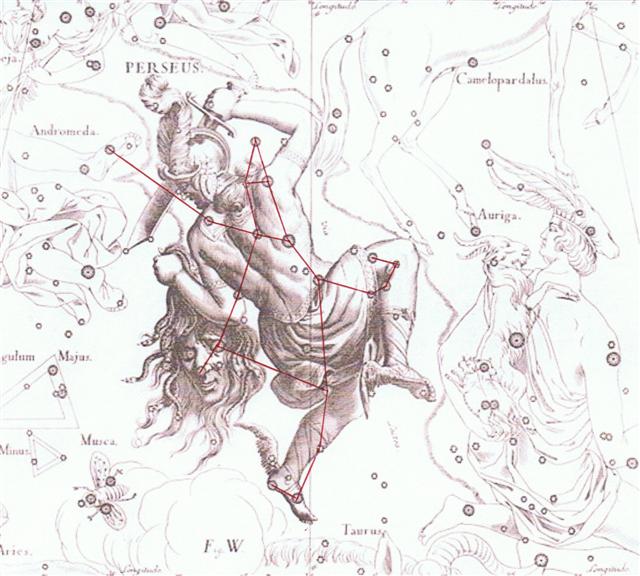3. Where are Atiks and Menkhib - the stars which I guess could stand at the beginning respectively at the end of 'the little valley' - as drawn in the Perseus figure?
Time runs from left to right (with Sun at right and shadows at left) and at the left heel is ο Persei, the star which in my astronomy book is named Atiks. The star named Menkhib in my book is ζ Persei, which is rising somewhat later and lower down compared to Atiks. Quite disturbing is the fact that on modern star maps the name Atik (not Atiks) is assigned to ζ Persei, while the star at the shin, ξ Persei (not ζ Persei), is named Menkib (not Menkhib).
"Atiq (also transliterated as Ateek, Ateeq, Attiq, Atik, or Attique ... is a male Arabic given name, the name is used in the Quran ... Meaning: 'Old or Ancient' ..." (Wikipedia) The idea of 'old' fits well with ο Persei (Atiks) because it comes immediately before the Pleiades. As to Menkhib Wikipedia states that it comes from the Arabic mankib, meaning 'shoulder'. Perhaps the significance of a shoulder is 'in front'? Allen, however, has another interpretation: "ζ ... is the Menkib of Burritt, from Mankib al Thurayya, the Shoulder of - i.e. next to - the Pleiades in the Arabian figure, although on modern charts it marks the left ankle. ο ... is Ati and Atik, from the word Al Άtik found on the Borgian globe, at the space between the shoulders, and applied to it by Ulug Beg; but it is now located near the left foot." Misam (κ Persei) - above Algol - is rising 9 days ahead of Atiks.
Misam seems to mean 'wrist' according to Allen. Furthermore, Menkar must be mentioned here, because it (α Ceti) is located at the 'snout' of the Whale:
"Menkar of the 'Alfonsine Tables' of 1521, Scaliger's Monkar, and now sometimes Menkab, from Al Minhar, the Nose, still is the popular, but inappropriate name, for it marks the Monster's open jaws. It is the prominent star in the northeastern part of the constellation, and culminates on the 21st of December." (Allen) "Alpha Ceti (α Cet, α Ceti) is a star in the constellation of Cetus. It has the traditional name Menkar or Menkab. The name Menkar derives from the Arabic ... manħar 'nostril' ..." (Wikipedia) Considering the differences between fishes and mammals I would say that menkab (nostril) ought to correspond to mankib (shoulder), and that both these words originate from a basic meaning of either 'the front of' or 'the top of'. Maybe we should say 'northeast'. |



